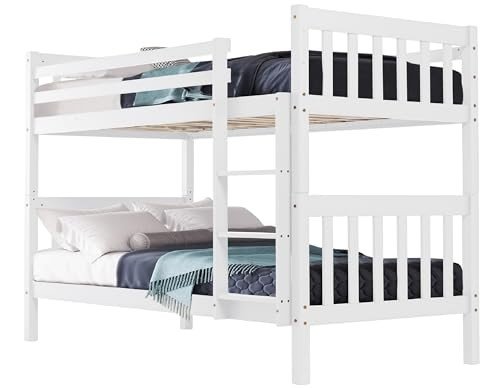10 Facts About Bunk Beds Children's That Insists On Putting You In A Good Mood
The Ultimate Guide to Bunk Beds for Children: Safety, Styles, and Benefits
When it comes to styling a kid's room, parents frequently face the double obstacle of making the most of space while making sure comfort and functionality. Bunk beds have become a popular service that attends to these requirements, using not just sleeping arrangements however likewise contributing to a room's visual. In visit here detailed guide, we will explore various elements of children's bunk beds, concentrating on their advantages, security functions, styles, and considerations for parents pondering this purchase.
Table of Contents
- Benefits of Bunk Beds
- Safety Features to Consider
- Types of Bunk Beds
- Design and Style Options
- Maintenance Tips
- Often Asked Questions (FAQs)
1. Advantages of Bunk Beds
Bunk beds provide many advantages for kids and their moms and dads. Here are some essential benefits:
Space-Efficiency: Bunk beds are an outstanding solution for smaller sized spaces. By stacking one bed on top of another, more floor space is readily available for play, storage, or study areas.
Affordable: When kids share rooms, bunk beds can decrease the requirement for purchasing two different beds, therefore saving money.
Promotes Social Interaction: Bunk beds can assist siblings or buddies bond by sharing a space, creating opportunities for social development.
Fun Factor: The concept of sleeping “up high” adds a playful aspect to bedtime, making the transition to sleeping alone simpler for some children.
Versatile Design: Bunk beds come in numerous designs, colors, and creates to match any space style, permitting personalization that reflects the child's personality.
2. Security Features to Consider
Safety is critical when it concerns children's furniture, especially in the case of bunk beds. Here are some important security features to assess:
Safety Feature
Description
Durable Construction
Frames made from strong wood or metal are preferred.
Guardrails
Ought to be at least 5 inches high and extend along both sides of the upper bunk.
Ladder Design
Ensure ladders are securely attached and have non-slip steps.
Mattress Size & & Fit
Should fit comfortably within the frame to avoid gaps.
Weight Limit
Constantly stick to the producer's weight limitation recommendations.
3. Kinds Of Bunk Beds
Bunk beds can be found in several styles, catering to different needs, preferences, and space sizes. Here are some typical types:
Standard Bunk Bed: The many basic type, with one bed on top of another.
Loft Bed: Features a high upper bed with space below for a desk or play location.
Futon Bunk Bed: Combines a leading bunk with a futon on the bottom, providing flexibility for seating and sleeping.
L-Shaped Bunk Bed: This design has the top bunk set at a perpendicular angle to the bottom, producing a small corner area.
Triple Bunk Bed: Accommodates three children utilizing stacked beds, ideal for large families or slumber parties.
4. Design and Style Options
When it comes to selecting a design for children's bunk beds, the options are essentially endless. Here are some popular designs:
Traditional Style: Often made from wood, these bunk beds feature elaborate details and are best for traditional or rustic-themed spaces.
Modern Style: Characterized by tidy lines and minimalist styles, contemporary bunk beds can be made of metal or wood.
Themed Bunk Beds: Some brands use bunk beds shaped like castles, vehicles, or play houses, making bedtime less of a chore.
Convertible Bunk Beds: These can be separated into 2 private beds, offering flexibility as kids grow.
Colorful Options: Bunk beds in lively colors can include a sense of pleasure and playfulness to any room.
5. Upkeep Tips
Preserving a bunk bed is essential for longevity and safety. Here are some ideas:
Regular Inspections: Check for loose screws or bolts every few months and tighten them as needed.
Cleaning up: Wipe down frames frequently to prevent dust accumulation; consider using a vacuum for hard-to-reach areas.
Bed mattress Care: Rotate bed mattress frequently and use protective covers to lengthen their life.
View for Wear and Tear: Look for any signs of damage in the wood or metal and consider replacing parts if needed.
Teach Kids Safety Rules: Encourage children to utilize ladders effectively and ensure they understand the safety features of their bed.
6. Frequently Asked Questions (FAQs)
Q1: What age is suitable for sleeping in a top bunk?
A1: Typically, children aged 6 and older are suggested for upper bunk sleeping, as they have the required motor abilities to climb up safely.
Q2: Do bunk beds include a mattress?
A2: Most bunk beds are offered as frames only, so you will need to buy bed mattress independently. Guarantee that the mattress fits the frame snugly.
Q3: Can bunk beds be separated later?
A3: Many designs allow conversion into two specific beds, providing versatility for future requirements.
Q4: How can I guarantee my kid's security on a bunk bed?
A4: Comply with security requirements and make sure guardrails, a tough frame, and a protected ladder are in place.
Q5: Are there weight limitations on bunk beds?
A5: Yes, constantly check the maker's specifications concerning weight limits to guarantee safety.
Bunk beds for kids can serve several purposes while ensuring safety and style. With diverse styles and designs readily available on the marketplace, parents can discover an unit that not only maximizes bedroom space however likewise shows their kid's special tastes. Just like any furniture, comprehending safety features, upkeep, and how they fit into a kid's lifestyle will guarantee that these beds stay a practical furnishings solution for years to come.
Through cautious factor to consider and adherence to security standards, bunk beds can supply a long-lasting, fun, and functional sleeping solution that children like.
